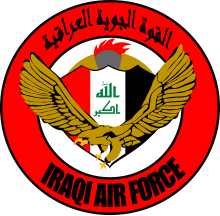
Back القوة الجوية العراقية Arabic Força Aèria Iraquiana Catalan ھێزی ئاسمانیی عێراقی CKB Irácké letectvo Czech Irakische Luftwaffe German Fuerza Aérea Iraquí Spanish نیروی هوایی عراق Persian Force aérienne irakienne French חיל האוויר העיראקי HE Angkatan Udara Irak ID
| Iraqi Air Force | |
|---|---|
| |
 Seal of the Iraq Air Force | |
| Founded | 22 April 1931 |
| Country | |
| Branch | Air force |
| Role | Aerial warfare |
| Size | Approximately 5,000 (2024)[1] ca. 192 aircraft[2] |
| Headquarters | Baghdad |
| Colours | Grey & White |
| Anniversaries | April 22 (Air Force Day)[3] |
| Engagements | |
| Commanders | |
| Current commander | Lieutenant General Shihab Jahid Ali |
| Insignia | |
|  |
| Fin flash |  |
| Flag |  |
| Aircraft flown | |
| Attack | Su-25, Aero L-159 Alca, KAI T-50, CH-4B, L-39 Albatros, Bayraktar TB2 |
| Bomber | Antonov An-32 |
| Fighter | F-16 Fighting Falcon |
| Helicopter | Mil Mi-17, Bell 212, Mil Mi-8, Eurocopter EC135 |
| Attack helicopter | Bell OH-58 Kiowa, Mil Mi-24, Mil Mi-28, Aérospatiale Gazelle |
| Reconnaissance | CH 2000, Ce 208 ISR, KA 350 ISR, ScanEagle, Raven RQ-11B |
| Trainer | Cessna 172, Cessna 208, T-6A, Utva Lasta 95, Boeing 727, An-26 |
| Transport | C-130 Hercules, C-130J, An-32B, KA 350ER |
The Iraqi Air Force (IQAF or IrAF) (Arabic: القوات الجوية العراقية, romanized: Al Quwwat al Jawwiyah al Iraqiyyah) is the aerial warfare service branch of the Iraqi Armed Forces. It is responsible for the defense of Iraqi airspace as well as the policing of its international borders. The IQAF also acts as a support force for the Iraqi Navy and the Iraqi Army, which allows Iraq to rapidly deploy its military. It is headquartered in Baghdad; the current commander is Lieutenant Gen. Shihab Jahid Ali.
The Iraqi Air Force was founded in 1931, during the period of British control in Iraq after their defeat of the Ottomans in the First World War, with only a few pilots. The Iraqi Air Force operated mostly British aircraft until the 14 July Revolution in 1958, when the new Iraqi government began increased diplomatic relationships with the Soviet Union. The air force used both Soviet and British aircraft throughout the 1950s and 1960s. When Saddam Hussein came to power in 1979, the air force grew quickly when Iraq ordered more Soviet and French aircraft. The air force's peak came after the long Iran–Iraq War, which ended in 1988, when it consisted of 1029 aircraft of all types, including 550 combat aircraft,[4] becoming the largest air force in the region. Its downfall came during the Persian Gulf War (1990–91) and continued while coalition forces enforced no-fly zones. The remnants of Iraq's air force were destroyed during the 2003 U.S.-led invasion.
After the invasion, the IQAF was rebuilt, receiving most of its training and aircraft from the United States. In 2007, Iraq asked Iran to return some of the scores of Iraqi fighter planes that flew there to escape destruction during the Persian Gulf War in 1991.[5] As of 2014, Iran was receptive to the demands and was working on refurbishing an unspecified number of jets.[6][7]
- ^ International Institute for Strategic Studies (13 February 2024). The Military Balance 2024 (1st ed.). Routledge. p. 358. ISBN 978-1032780047.
- ^ Cite error: The named reference
World Air Forces 2024was invoked but never defined (see the help page). - ^ Cite error: The named reference
GSwas invoked but never defined (see the help page). - ^ BRODER, JOHN M.; JEHL, DOUGLAS (13 August 1990). "Iraqi Army: World's 5th Largest but Full of Vital Weaknesses : Military: It will soon be even larger. But its senior staff is full of incompetents, and only a third of its troops are experienced". Los Angeles Times. Archived from the original on 16 March 2016. Retrieved 16 October 2017.
- ^ Colvin, Ross (5 August 2007). "Iraq air force wants Iran to give back its planes". Reuters. Archived from the original on 11 October 2017. Retrieved 16 December 2017.
- ^ "With new US planes slow to arrive, Iraq seeks remnants of Saddam's air force to bomb ISIL". 28 June 2014. Archived from the original on 24 August 2017. Retrieved 23 August 2017.
- ^ "Iraq cobbling together makeshift air force to fight ISIS". The Washington Post. Archived from the original on 1 September 2017. Retrieved 23 August 2017.